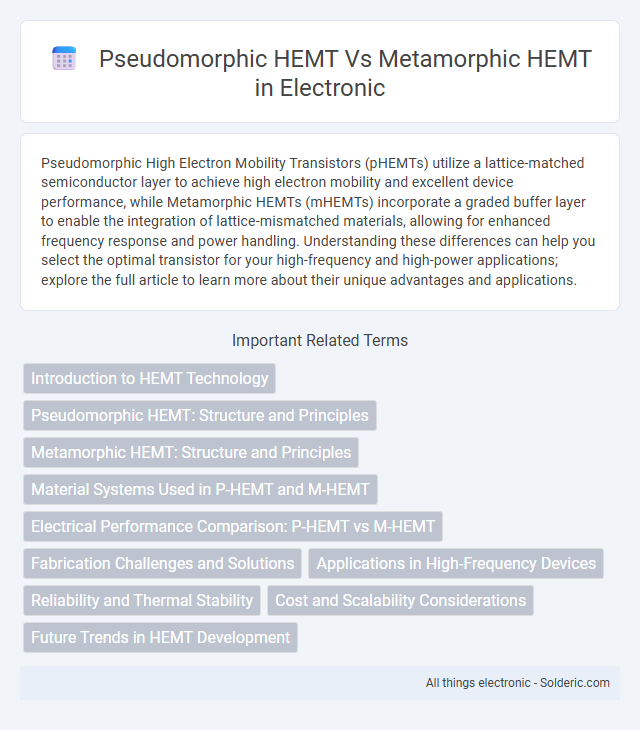Pseudomorphic High Electron Mobility Transistors (pHEMTs) utilize a lattice-matched semiconductor layer to achieve high electron mobility and excellent device performance, while Metamorphic HEMTs (mHEMTs) incorporate a graded buffer layer to enable the integration of lattice-mismatched materials, allowing for enhanced frequency response and power handling. Understanding these differences can help you select the optimal transistor for your high-frequency and high-power applications; explore the full article to learn more about their unique advantages and applications.
Comparison Table
| Feature | Pseudomorphic HEMT (pHEMT) | Metamorphic HEMT (MHEMT) |
|---|---|---|
| Substrate | GaAs (Gallium Arsenide) | GaAs or Si with metamorphic buffer |
| Channel Material | InGaAs lattice-matched to GaAs | InGaAs with relaxed lattice, allows higher indium content |
| Electron Mobility | High, limited by lattice matching | Higher, due to relaxed lattice and optimized channel |
| Frequency Performance | Up to 100 GHz typical | Exceeds 200 GHz |
| Fabrication Complexity | Lower, standard epitaxy | Higher, involves metamorphic buffer layers |
| Strain Engineering | Minimal strain due to lattice matched layers | Engineered strain in buffer to accommodate mismatch |
| Cost | Lower | Higher, due to complex growth |
| Application | Microwave amplifiers, low-noise devices | High-frequency, mm-wave communication, radar |
Introduction to HEMT Technology
High Electron Mobility Transistors (HEMTs) leverage heterojunctions to achieve superior electron mobility and high-frequency performance. Pseudomorphic HEMTs (pHEMTs) utilize strain-engineered epitaxial layers matched to the substrate lattice, reducing dislocations and enhancing carrier mobility. Metamorphic HEMTs (mHEMTs) incorporate lattice-mismatched buffer layers to enable the use of different semiconductor materials, expanding bandgap engineering options and optimizing device performance for high-power and microwave applications.
Pseudomorphic HEMT: Structure and Principles
Pseudomorphic HEMTs (pHEMTs) feature a thin, strained layer of InGaAs grown on a GaAs substrate, creating a high-electron-mobility channel due to lattice mismatch-induced strain. This heterostructure leverages quantum well confinement to enhance electron mobility and reduce scattering, resulting in superior high-frequency performance. The precise control of layer thickness and composition in pHEMTs enables optimized electron transport properties critical for low-noise and high-speed applications.
Metamorphic HEMT: Structure and Principles
Metamorphic HEMTs utilize an epitaxial layer grown on a substrate with a different lattice constant, enabling larger bandgap engineering and higher electron mobility compared to Pseudomorphic HEMTs. The metamorphic buffer layer relaxes strain, allowing superior performance in high-frequency and high-power applications by reducing dislocation density and enhancing carrier confinement. Your choice of Metamorphic HEMT impacts device reliability and efficiency due to these unique structural and electronic principles.
Material Systems Used in P-HEMT and M-HEMT
Pseudomorphic HEMTs (P-HEMTs) typically utilize lattice-matched materials like InGaAs/GaAs or InAlAs/InGaAs/InP to achieve high electron mobility while maintaining crystal quality, ensuring minimal defects at the heterojunctions. Metamorphic HEMTs (M-HEMTs) grow lattice-mismatched materials such as InGaAs on relaxed buffer layers of GaAs or Si substrates, allowing your devices to benefit from enhanced electron mobility despite strain-induced defects. The choice between P-HEMT and M-HEMT material systems directly impacts device performance, cost, and integration possibilities in high-frequency and power applications.
Electrical Performance Comparison: P-HEMT vs M-HEMT
Pseudomorphic HEMTs (P-HEMTs) exhibit higher electron mobility and lower noise figures compared to Metamorphic HEMTs (M-HEMTs) due to the lattice-matched channel that reduces interface defects. M-HEMTs offer greater material flexibility and higher breakdown voltage, benefiting power and high-frequency applications despite slightly lower electron mobility than P-HEMTs. The trade-off between electrical performance and material versatility makes P-HEMTs preferred for ultra-low noise and high-speed devices, while M-HEMTs excel in applications requiring wider bandgap engineering and enhanced power handling.
Fabrication Challenges and Solutions
Pseudomorphic HEMTs (pHEMTs) face fabrication challenges mainly due to the strict lattice matching requirements between the substrate and epitaxial layers, which necessitate precise control over molecular beam epitaxy (MBE) or metal-organic chemical vapor deposition (MOCVD) growth parameters to minimize defects and dislocations. Metamorphic HEMTs (mHEMTs) encounter strain relaxation and defect management issues caused by the lattice mismatch when incorporating metamorphic buffer layers, addressed through optimized graded buffer designs and low-temperature nucleation to reduce threading dislocation densities. Advanced in situ monitoring techniques and high-quality buffer engineering have significantly improved crystal integrity, enabling enhanced device performance and reliability in both pHEMT and mHEMT technologies.
Applications in High-Frequency Devices
Pseudomorphic HEMTs (pHEMTs) excel in high-frequency applications such as RF amplifiers and microwave communication systems due to their superior electron mobility and low noise characteristics. Metamorphic HEMTs (mHEMTs) enable integration on diverse substrates, offering higher power density and frequency performance ideal for advanced radar systems and millimeter-wave technology. Your choice between pHEMT and mHEMT depends on specific device requirements, balancing performance with substrate compatibility for optimal high-frequency operation.
Reliability and Thermal Stability
Pseudomorphic HEMTs (pHEMTs) exhibit superior reliability and thermal stability due to their strained-layer epitaxy on lattice-matched substrates, minimizing defects and enhancing electron mobility. Metamorphic HEMTs (mHEMTs) offer greater material flexibility for higher frequency applications but often experience increased dislocation densities, which can compromise long-term reliability and heat dissipation. Choosing between pHEMT and mHEMT involves evaluating your device's operational environment where pHEMTs excel under rigorous thermal stress and demand consistent performance over time.
Cost and Scalability Considerations
Pseudomorphic HEMTs (pHEMTs) generally offer lower manufacturing costs due to established fabrication processes on lattice-matched substrates, enhancing scalability for high-volume production. Metamorphic HEMTs (mHEMTs) enable the use of diverse substrates, increasing design flexibility but often incurring higher costs and complexity during scale-up. Your choice between pHEMT and mHEMT should weigh budget constraints against performance needs and production scalability goals.
Future Trends in HEMT Development
Future trends in Pseudomorphic HEMT (pHEMT) and Metamorphic HEMT (mHEMT) development emphasize enhancing electron mobility and thermal management for higher frequency and power applications. Advances in epitaxial growth techniques aim to minimize lattice mismatch in mHEMTs, improving device reliability and performance beyond pseudomorphic limits. Integration with wide-bandgap materials like GaN is driving innovations in both pHEMT and mHEMT architectures for next-generation RF and mm-wave electronics.
Pseudomorphic HEMT vs Metamorphic HEMT Infographic

 solderic.com
solderic.com